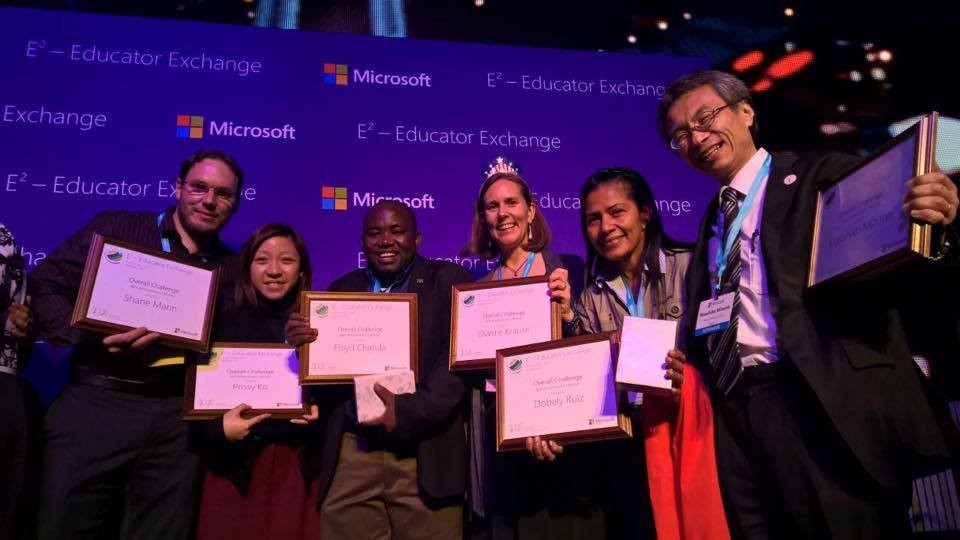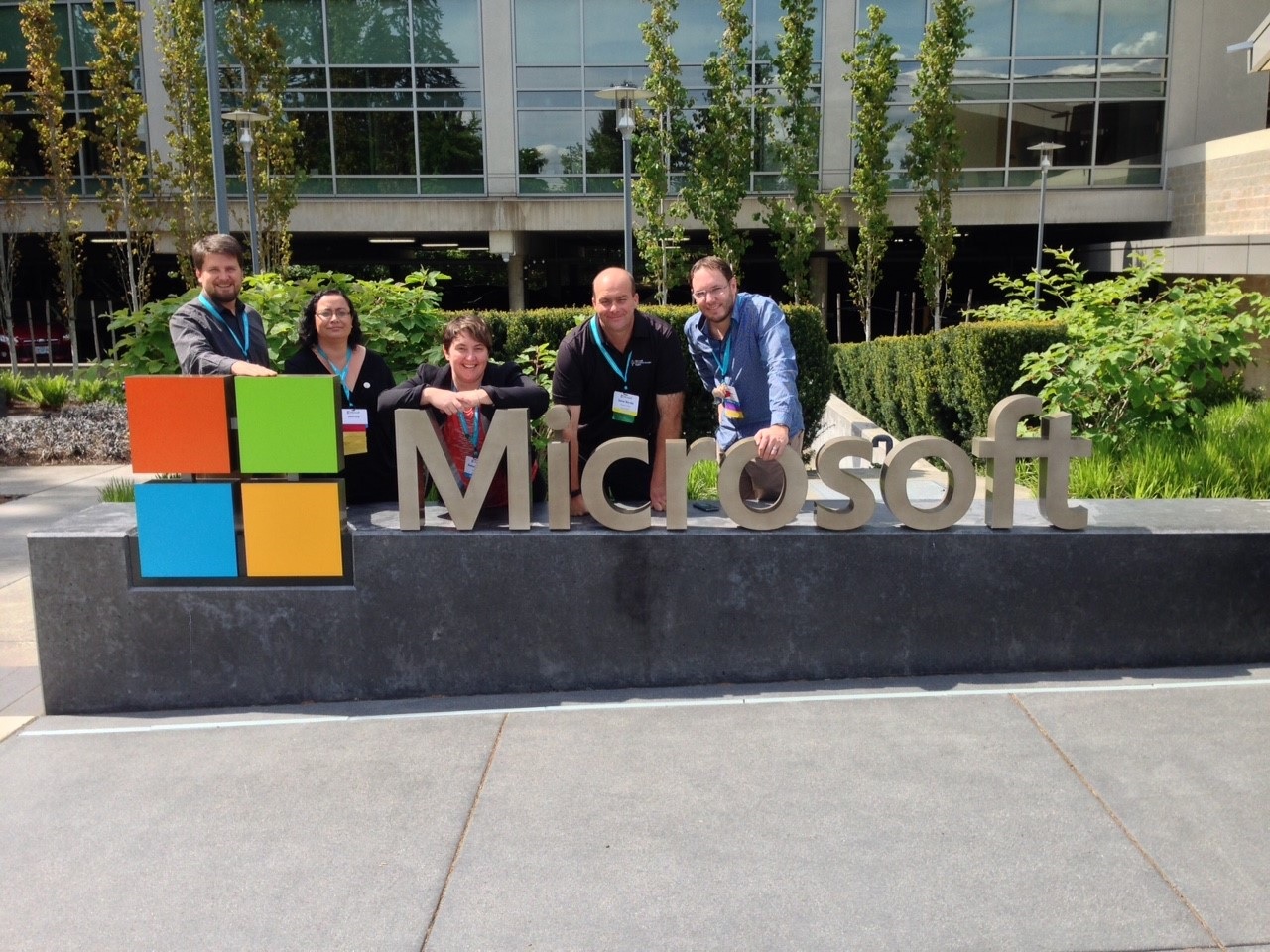Reflections and learnings from the E2 Global Educator Exchange conference
The five New Zealand MIE Experts at Microsoft, Redmond.
From left: Ben Hilliam, Nikkie Laing, Rachel Chisnall, Steve Martin, Shane Mann
From April 28 - May 1, Microsoft NZ's Schools and Academic Programmes manager Anne Taylor accompanied a group of five talented Microsoft Innovative Educator (MIE) Experts as they travelled to Redmond, Washington for the E2 Global Educator Exchange conference. Here they joined 300 other MIE Experts and Student Ambassadors from around the world. Over three days, the New Zealand teachers were able to learn, collaborate and celebrate their achievements with their international peers.
The five New Zealand educators were personally invited to attend E2 following a selection process that evaluated them on various criteria including innovation in using technology to solve challenges faced within the classroom, and how they are re-thinking teaching, learning and assessment in order to improve learning outcomes and equip students with the skills they need in the modern workplace.
The E2 Global Educator Exchange event is part of the Microsoft in Education initiative that offers a range of professional development programs to bridge the gap between technology skills and innovative teaching. These programs reach beyond traditional software training to provide a scaffold that supports educators and school leaders of all skill levels on their learning journey. Through these programs, Microsoft has trained more than 10 million educators and reached more than 200 million students since 2003.
Now that the New Zealand teachers have had time to absorb everything they learnt at the three-day conference, we'd like to share their highlights, learnings, and their vision of the future of Microsoft in education.
Rachel ChisnallTaieri College, Dunedin
Read more of Rachel's reflections in her blog post
What was the highlight of the summit?
The highlight for me was the Teachmeet. I got lots of really useful comments on my learning activity, saw some amazing things that other educators are doing and made some valuable connections - including a teacher in Russia who has already been in contact. I also got to share my learning activity with Anthony Salcito [Microsoft Vice President - Worldwide Education] and found he was really clued up on education in New Zealand.
What were your key takeaways?
That is wasn't solely about the tech. Technology is there to support collaboration, innovation and anytime, anywhere learning. I was also really impressed with the efforts to grant universal access to technologies so that there are less barriers to learning for students from disadvantaged areas, for example the initiative to use the white space between TV channels to provide internet access.
What is your vision of the future of Microsoft technologies in education?
That they are rapidly moving forward, and very responsive to student and educator feedback. Microsoft want to break down any barriers that are there to ensure everyone who wants to learn, can learn. And it would seem they want to have some fun doing it!
Ben HilliamSt Andrew's College, Christchurch
Read more about Ben's experiences on the StAC e-Learning Stories blog
What were your key takeaways?
I was really impressed by how teachers are using technology around the world. We all teach in incredibly different contexts throughout the world, yet are still trying to improve the educational outcomes for our students. I felt challenged about how I can measure my effectiveness as a teacher and how I can create a more engaging environment for my classes.
What is your vision of the future of Microsoft technologies in education?
OneNote is central to everything I will be using. Office Mix is a close second. Flipped classrooms will become common place and teachers will need to employ technology that is seamless with education. The Surface Pro 3 has found a stronghold in my class and those students using it no longer need pen and paper. Education can now start to become anytime, anywhere.
Nikkie Laing
Opaheke School, Auckland
What was the highlight of the summit?
The highlight of the summit for me was definitely the feedback from my peers! It was amazing to be reminded that in our little corner of the world we can definitely hold our own with the best educators globally. Our kids and teachers are doing amazing things with technology!
What were your key takeaways?
My key takeaway was that it is important to be brave with technology and teaching. We need to keep taking risks to do things in bigger and better ways to benefit our students. I think New Zealand's No.8 wire mentality gives us an advantage over the rest of the world in this respect. If something hasn't been attempted at your school, be brave enough to try it out!
What is your vision of the future of Microsoft technologies in education?
I can see amazing technology becoming more accessible and available for all students to ensure leaning can happen anywhere, anytime. Learning happens everywhere, not just inside classrooms, and this is more obvious than ever as teachers become leaners alongside their students when learning with digital technology. We are all learners and teachers at the same time. These technologies also allow for significantly more personalisation, we can take as long as we need to learn something new and we can learn in a myriad of different ways. We don’t have organise learning into discrete lesson sized proportions that will work for everyone instead we can, review, revisit, expand and extend learning where and when needed.
Shane Mann
Rathkeale College, Masterton
What was the highlight of the summit?
Definitely the E2 Educator Challenge. We were put into groups of 5 teachers from around the world and given the task of creating a learning activity that linked in with conference theme of Bravery, Courage and Leadership. I was teamed up with some amazing educators from a wide range of teaching backgrounds and cultures. Despite some language barriers, very different teaching backgrounds and experience, we worked collaboratively over a few days to develop the learning activity ‘Global Energy - What alternative do we have?’ where students would investigate and learn about energy and power sources that could be alternatives to their main source of energy. Our learning activity was then presented to an audience and judges in the form of a 5 minute Sway presentation: Global Energy – What alternative do we have. The pitch was delivered by the group with passion and enthusiasm and we were later recognised as the overall challenge winners! We are now working hard to put our plan into action, starting with a focus on one of the team member's school in Zambia. Our students will collaborate globally, working across multiple subject areas to develop a working renewable energy solution for the school.
 Shane Mann with his winning team
Shane Mann with his winning team
What were your key takeaways?
The key takeaway for me was that some of the best presentations and examples of innovative use of technology came from the ANZAC MIE team! It was fantastic to see the work that is happening right on our back door step is easily up there with some of the best in the world. The conference enabled us to connect and share ideas with some of the top educators in the world. Being part of the Teach Meet, E2 Challenge and MIE presentations was a truly amazing and eye opening experience that I would easily class as the best professional development experience of my life.
What is your vision of the future of Microsoft technologies in education?
OneNote, Office 365 and Surface are the big winners here! The combination of OneNote (with the OneNote Class Notebook Creator), Office 365 and the Surface 3 / Surface Pro 3 are revolutionising education. These tools have made the greatest impact of any other technology in my classroom. Some examples include the ability to collaborate via OneNote with students, provide feedback and feed forward effortlessly, create interactive content via products such as Sway, Office Mix and OneNote, annotate and draw with the Surface pen, survey students via Excel Survey………the list goes on and on! In addition to this, I see teachers worldwide becoming increasingly connected with each other through the use of Yammer, Facebook and Twitter. This is a very exciting time to be involved in the rapidly changing landscape of e-learning in education. I feel as if I have only scratched the surface of what is possible and look forward to what the future holds!
Steve Martin
Howick College, Auckland
What was the highlight of the summit?
Listening to Ziauddin Yousafzai the father of Malala E- it brought to the fore the importance of education in its influence on developing people who are willing to stand up for what is right and to ensure their stories of bravery are used as inspiration to others.
What were your key takeaways?
Firstly, that Microsoft are genuinely and passionately engaged in developing tools and opportunities that are aimed at improving outcomes for students through education. Secondly, that purposeful innovation in the use of digital technologies takes courage and persistence.
What is your vision of the future of Microsoft technologies in education?
The commitment and openness of Microsoft developers and program managers that I met whilst at the summit reinforces a vision that the technologies being developed will further enhance students’ ability to build learning connections, interact with the world around them, and develop skills and competencies that are essential in building their successful futures.
To become a part of the Microsoft Innovative Educator (MIE) Experts program, visit the Microsoft Educator Network for more information
